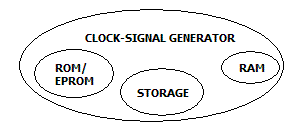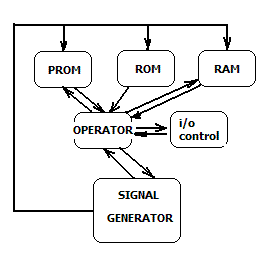I love working in U6's. It has a fundamental functional environment with an unlimited number of parallel GUIs that incorporates in itself :
- Its memory and the processor have been integrated into one, photonic device based on optical signalling.
- Programming is based on Logic and Symbol equivalent logic code (see U6 languages below)
- An engineering shell for any number of machines invocable from any of the remote, recognized computers
- An SGML-HTML like environment for Internet interface, organically self-written - forget the XML hassles!
- A file and server Protocol Self-Writing facility
 or, in PC terms:
or, in PC terms:
 The Operators!
Forget the CPU. U6 core, if you will, is an operator made up of operators. Imagine a wheel with hub and spokes. Or better yet, the solar system. There is arrays, the central operator, which would remind you of addresses. Everything else is located (figuratively speaking) around the arrays.
The Operators!
Forget the CPU. U6 core, if you will, is an operator made up of operators. Imagine a wheel with hub and spokes. Or better yet, the solar system. There is arrays, the central operator, which would remind you of addresses. Everything else is located (figuratively speaking) around the arrays.
Array Task Manager operator has in itself a group of managers each referred to as When, What, Where, How and How Many managers. The Array Task Manager often is the most crucial component, resembling a kernel in other systems.
Array Definition and Tagging (Addressing) sets up arrays according to the needs of the operation, as well as defines the arrays' discreet dimensions, tags, remembers and searches unique location addresses within all of the arrays.
Search and Iteration set of components conducts all the array searches by any of the value methods, it defines iterations according to search operations. Search and Iteration processors (which are, again, hyper-vector) actively search, find and provide found values, or sets of values, by comparing, matching and other methods that would remind you of hash and range math.
Symbol Processor is the equivalent of a CPU processor, except that it uses all of symbols of any symbol logic it creates for an operation, and uses for operation to calculate processes.
Translators simultaneously translate between different symbol logic systems, value methods, math algorithms, thereby allowing many different machine languages, solid-state PC bit systems and their operating systems to function on a single U6 platform in perfect harmony.
Calculators calculate any math, logic or other value method functions, algorithms and formulas that require result computations and excludes process decision-making (process calculation), which is done by the symbol processor.
Comparators compare entire processes, sets, algorithms, tasks, functions and other activities simultaneously, and substantially faster than your regular Cray or other electronic machines - since sets, algorithms and activities exist as objects relative to the . Unlike the Search and Iteration operator that reaches into locations to search and find, the Comparators receive sets of activities to be compared in decision making.
Programming and Logic later. Isn't U6 cool?